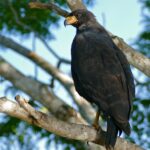Great Black Hawks (Buteogallus urubitinga) are birds of prey that are slightly larger and lankier than Common Black Hawks, with longer legs and tails. They are non-migratory in most of their range but are only summer visitors in the United States, where they arrive mostly in March and depart mostly in September and October.
Arrival and Departure of Great Black Hawks in the United States
Great Black Hawks are limited to the edges of flowing streams in the arid southwest of the United States. They arrive in the United States mostly in March and depart mostly in September and October. This means that the Great Black Hawks are only summer visitors in the United States, and they are non-migratory in most of their range.
| Month | Arrival/Departure |
|---|---|
| March | Arrival |
| September-October | Departure |
Hunting Techniques of Great Black Hawks
 Image source: Great Black Hawk by Bernard DUPONT
Image source: Great Black Hawk by Bernard DUPONT
Great Black Hawks are creative hunters and employ various hunting techniques to capture different prey. They hunt mostly by watching from low perches, then gliding down to catch prey in their talons. Sometimes, they hunt actively along streams by moving from rock to rock at the water’s edge and sometimes wade in shallow water, stirring up prey.
They feed on a wide variety of small creatures, but especially those found in water. In the United States, they eat mostly fish, frogs, tadpoles, and lizards, plus some small birds, snakes, rodents, and insects. In the tropics, their diet may include many crayfish, crabs, large insects, and even fruits.
Nesting and Breeding of Great Black Hawks
Great Black Hawks build a platform nest made of sticks constructed high up in an emergent tree or on power poles. The female will lay one egg which is white with red to purplish-brown markings. The eggs must be incubated for between 35-37 days. After the nestling hatches, it will grow quickly, and the male will work hard to bring enough food to the nest for the female and his offspring.
The male will bring food close to or at the nest tree, and the female will retrieve it and bring it to the nest and feed her offspring. When the nestling is around 40 days old, it will be ready to fly from the nest for the first time. After it fledges, it will remain with its parents for several months, learning how to hunt and survive on its own.
Conclusion
Great Black Hawks are fascinating birds of prey that are slightly larger and lankier than Common Black Hawks, with longer legs and tails. They are non-migratory in most of their range but are only summer visitors in the United States, where they arrive mostly in March and depart mostly in September and October. They are limited to the edges of flowing streams in the arid southwest and have very broad wings, short tails, and long legs. They are creative hunters and employ various hunting techniques to capture different prey, and they build a platform nest made of sticks constructed high up in an emergent tree or on power poles.
References:
– https://ebird.org/species/grbhaw1
– https://www.audubon.org/field-guide/bird/common-black-hawk
– https://peregrinefund.org/explore-raptors-species/hawks/great-black-hawk


